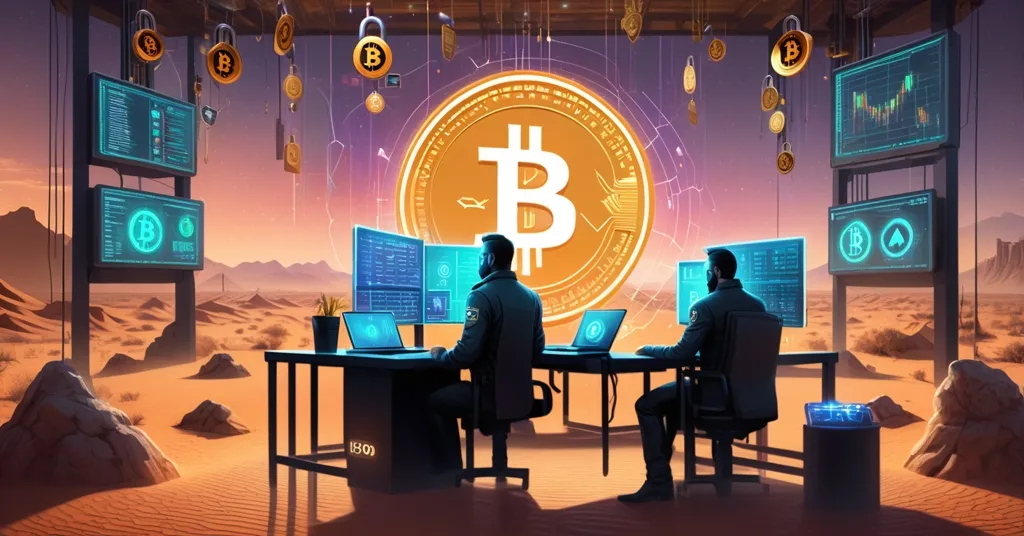BingX Review 2025: Safety, Legitimacy, and Risks for Crypto Traders Unveiled

BingX Review 2025: Is This Crypto Exchange Safe and Legit?
BingX, a cryptocurrency exchange launched in 2018 by Josh Lu, has rapidly gained traction, boasting over 10 million users across 150+ countries with a daily trading volume of $355 million in spot and $5 billion in futures. But behind the glossy numbers and innovative tools, does it stand up to scrutiny on safety, legitimacy, and usability for Bitcoin enthusiasts and altcoin traders alike? Let’s dive deep into what BingX offers, where it shines, and where it stumbles—because in the Wild West of crypto, not every platform is built on solid ground.
- Global Player: Serves over 10 million users in 150+ countries, but restricted in key markets like the US.
- Feature-Packed: Spot, futures, derivatives, copy trading, and grid bots for all trader levels.
- Red Flags: High fees, regulatory gaps, and user complaints about withdrawals cast shadows.
Trading Features: What BingX Brings to the Table
BingX isn’t just another exchange in the crowded crypto space; it’s a platform aiming to cater to everyone from wide-eyed newbies to battle-hardened degens. At its core, it offers spot trading for straightforward buy-and-sell transactions—think of it as the bread and butter for those holding Bitcoin or dabbling in altcoins. For the risk-takers, futures trading comes in two flavors: standard and perpetual, allowing speculation on price movements without owning the underlying asset. Then there’s derivatives trading with leverage up to 150x, meaning you can borrow funds to amplify your position—so a $1,000 stake could control $150,000 worth of crypto. But beware: while the potential gains are massive, a tiny price dip can wipe you out faster than you can say “liquidation.”
What really makes BingX stand out are its social and automated trading tools. Copy trading is a game-changer for beginners; it lets you mirror the moves of 17,000 elite traders on the platform. Imagine being a rookie who doesn’t know a candlestick chart from a stick of gum, yet still raking in profits by following a pro’s playbook. Grid trading bots are another gem—automated scripts that execute buy and sell orders within a set price range, profiting from market swings while you sleep. BingX Wealth offers asset management for those chasing passive income, and a P2P marketplace supports over 30 fiat currencies for direct peer-to-peer trades. With over 900 cryptocurrencies and 1,000+ trading pairs, whether you’re a Bitcoin maximalist or an altcoin moonshot hunter, there’s something here to play with.
Fees and Limits: Counting the Cost
Let’s talk numbers, because innovation doesn’t come cheap. BingX keeps spot trading fees competitive at 0.1% for both makers (those placing limit orders) and takers (those filling existing orders), which is on the lower end compared to industry averages of 0.1% to 0.25%. Futures trading is even sweeter, with fees at 0.02% for makers and 0.05% for takers on perpetual contracts, and 0.045% on closing for standard contracts. That’s a better deal than some heavyweights out there, though unlike Binance with its BNB token, BingX lacks a native coin to slash fees further.
Withdrawal limits depend on your verification status. Unverified users are capped at 20,000 USDT per 24 hours, while those completing Basic KYC can withdraw more, and Advanced KYC unlocks up to 5,000,000 USDT daily. Sounds generous, right? Not so fast—withdrawal fees can sting like a wasp. For instance, pulling USDT out on the ERC-20 network costs a hefty $28, more than a fancy dinner in some places. If you’re moving funds often, these charges pile up, making BingX less appealing for frequent transactions compared to competitors with leaner fee structures.
Security: Fortress or Facade?
In a post-FTX world where trust in exchanges is as fragile as a glass hammer, security isn’t just a feature—it’s a lifeline. BingX pulls out the stops with two-factor authentication (2FA), anti-phishing codes, address whitelisting, and SSL encryption to shield your assets. More impressively, they offer proof of reserves audited by Mazars, guaranteeing a reserve ratio of at least 100%—meaning they hold enough crypto to back every user deposit. They even provide Merkle Tree verification for major coins like Bitcoin, Ethereum, and USDT. For the uninitiated, this is a cryptographic tool acting like a digital fingerprint, letting you independently confirm your funds are accounted for in their reserves. It’s a rare transparency move, especially when many exchanges still play hide-and-seek with user trust.
But here’s the rub: no amount of fancy tech can fully erase user skepticism. Scattered across platforms like WikiBit and Trustpilot are tales of withdrawal delays, account blocks, and customer support that’s slower than molasses in winter. Some users allege being forced to deposit more funds just to unlock stuck assets—a scam tactic if true. While BingX hasn’t faced a major hack on the scale of Mt. Gox, these complaints suggest operational cracks that could bite even the most cautious trader. Transparency is great, but if you can’t access your Bitcoin when you need it, what’s the point?
Regulatory Roadblocks: A Patchwork of Access
BingX’s global reach hits a wall in several major markets due to regulatory hurdles. If you’re in the United States, China, Japan, Canada, the UK, Hong Kong, Singapore, or a handful of others, you’re out of luck. In the US, for instance, strict SEC rules and licensing requirements keep BingX at bay, a common hurdle for many exchanges navigating the murky waters of crypto regulation as outlined in this list of restricted countries. The platform holds licenses in Australia (AUSTRAC) and Lithuania (FSIC), which is a start, but claims of FinCEN registration in North America remain unverified, raising eyebrows about their compliance narrative. For supported regions like Germany, India, Brazil, Nigeria, South Africa, Turkey, Russia, Ukraine, and Argentina, BingX is a viable option, yet this patchwork of access highlights a broader issue: legal frameworks often lag behind tech, stifling crypto adoption for millions.
Know Your Customer (KYC) policies are optional, a rarity that nods to privacy hawks who hate handing over personal data to centralized entities. Unverified accounts face tighter limits, while Basic and Advanced KYC levels unlock higher withdrawal caps and fee perks. It’s a trade-off between freedom and functionality, aligning with the decentralization ethos we champion. But user feedback paints a grimmer picture—reports of forced verification mid-transaction or blocked accounts without clear recourse suggest BingX’s privacy stance might be more marketing than mission.
User Experience: Glitches and Gripes
BingX markets itself as intuitive for first-timers, with a slick interface and tools like copy trading to ease the learning curve. They even dangle incentives like a $30 welcome bonus and rewards up to $6,000, earning a user score of 9.5 in some circles. Their 2024 partnership with Chelsea FC is a clever bid to win over mainstream crowds, much like Binance’s global sponsorships. But dig into user reviews on Reddit, and the shine wears off. Traders report platform glitches, slippage—where trades execute at worse prices than expected due to rapid market shifts or low liquidity—and order delays during volatile periods. If you’re leveraging at 150x, a split-second lag could cost you everything. Customer support? Often described as a black hole, with responses taking days or weeks, if they come at all.
Picture this: you’re a newbie who’s just copied a top trader, riding a Bitcoin rally, only to find your withdrawal stuck for days with no explanation. These aren’t just one-off rants; they point to systemic issues that could derail even seasoned traders. For all its bells and whistles, BingX’s operational reliability seems to buckle under pressure, a dealbreaker in a market that never sleeps.
Comparing the Field: BingX vs. Giants Like Binance and Coinbase
How does BingX stack up against the titans of the exchange world? Compared to Binance, founded in 2017 by Changpeng Zhao, BingX offers higher leverage (150x vs. Binance’s 125x in some markets) and unique social trading tools, but falls short on fee discounts without a native token like BNB and lacks direct fiat-to-crypto trading—a staple on Binance. For a deeper look, check this BingX vs. Binance comparison. Coinbase, launched in 2012 by Brian Armstrong and Fred Ehrsam, prioritizes US compliance and simplicity, making it a go-to for American beginners, while BingX’s regulatory exclusion from the US and higher fees make it less appealing for that demographic. Bybit and MEXC, both founded in 2018, match BingX on high leverage and low fees, but BingX edges out with copy trading—a niche for social learners.
For Bitcoin maximalists, BingX supports the king of crypto with transparent reserves and robust trading pairs, aligning with the push for a decentralized financial future. Yet its catalog of 900+ altcoins might dilute focus from BTC’s dominance, a point of contention for purists. Altcoin speculators, however, will find plenty to gamble on. Ultimately, BingX carves a niche with innovation, but lacks the regulatory footing and fiat support of its bigger rivals, leaving it as a riskier bet in some respects.
Playing Devil’s Advocate: Innovation or Illusion?
Let’s flip the script and poke holes in the hype. Copy trading sounds like a golden ticket—mirroring pros to make bank without the grind. But does it just breed dependency, turning newbies into lemmings who crash off a cliff when their “elite trader” makes a bad call? High leverage at 150x is another double-edged sword; sure, it amplifies gains, but it’s a reckless gamble in a market where Bitcoin can swing 10% in hours. Should exchanges like BingX even promote such tools, or are they preying on overconfident traders? And while optional KYC screams privacy, the reality of withdrawal hassles and forced verifications undercuts that libertarian dream. BingX pushes boundaries, but at what cost to user autonomy and safety? For broader insights, take a look at community opinions on Quora.
The Bigger Picture: Decentralization and Adoption Challenges
BingX’s P2P marketplace and optional KYC nod to the ethos of decentralization and financial freedom we hold dear, especially for Bitcoin’s vision of trustless money. Their transparency with proof of reserves post-FTX is a step toward disrupting centralized finance, aligning with effective accelerationism—pushing tech forward to reshape broken systems. Yet regulatory bans in major markets like the US expose the clash between innovation and control, slowing crypto’s march to mainstream adoption. If platforms can’t navigate these legal minefields, are we really closer to a decentralized future, or just playing whack-a-mole with bureaucrats?
User trust issues are another ticking time bomb. Withdrawal delays and account blocks aren’t just annoyances—they erode faith in exchanges as custodians of our hard-earned crypto. For every step BingX takes toward transparency, operational missteps pull it back. This isn’t unique to them; it’s a systemic flaw in an industry still grappling with balancing user empowerment and reliability. As we champion Bitcoin and blockchain’s potential, we can’t ignore these growing pains. For more background on the exchange, check its Wikipedia page.
Looking Ahead: BingX in 2025 and Beyond
What’s next for BingX as we peer into 2025? Regulatory winds could shift—clearer crypto laws in regions like the EU or even the US might ease restrictions, expanding access. Their social trading tools could drive mainstream adoption, luring normies into the fold with promises of easy profits. But unresolved user trust issues and operational hiccups loom large. If BingX can’t fix withdrawal woes or bolster support, no amount of Chelsea FC branding will save its rep. For now, it’s a platform with promise, but one that must prove it can walk the tightrope of innovation without falling into the abyss of user distrust. Curious for a deeper dive? Start with this comprehensive BingX review for 2025.
Key Takeaways and Questions for Crypto Traders
- What is BingX, and why should crypto traders care?
BingX, launched in 2018, is a cryptocurrency exchange serving over 10 million users with spot, futures, derivatives trading, and tools like copy trading and grid bots. It’s relevant for its accessibility to beginners and high-leverage options for pros, though not without serious flaws. - Is BingX safe for trading Bitcoin and other cryptocurrencies?
BingX boasts 2FA, SSL encryption, and Mazars-verified proof of reserves at 100% coverage for assets like Bitcoin. Yet user reports of withdrawal delays and account blocks signal trust risks that can’t be ignored. - What are BingX’s standout features for new and veteran traders?
Copy trading lets rookies mirror 17,000 elite traders, while grid bots automate strategies for pros. With 900+ cryptocurrencies, it suits Bitcoin hodlers and altcoin speculators alike. - What are the biggest risks of using BingX for crypto trading?
Steep withdrawal fees ($28 for USDT on ERC-20), glitches like slippage, restrictions in markets like the US, and abysmal support responsiveness are glaring concerns for any trader. - How does BingX compare to Binance or Coinbase in the exchange race?
BingX leads with social trading and 150x leverage over Coinbase’s beginner focus, but trails Binance on fees and fiat support, lacking the regulatory clout both rivals wield in key regions. - Why do regulatory restrictions limit BingX, and what’s the impact on crypto adoption?
Bans in the US, China, and beyond stem from strict licensing laws clashing with crypto’s decentralized ethos, slowing platforms like BingX and exposing the urgent need for updated global rules to boost adoption. - Should Bitcoin maximalists trust BingX despite its altcoin-heavy catalog?
Yes, BingX supports Bitcoin with transparent reserves and solid tools, fitting BTC’s decentralized vision, though its 900+ altcoins might distract from a pure Bitcoin-first focus.
So, is BingX safe and legit? The verdict is a cautious maybe. Its security protocols and transparency efforts—especially proof of reserves—show a commitment to user protection in an industry riddled with scams and collapses. But high fees, operational stumbles, and a barrage of user complaints about withdrawals and support can’t be swept under the rug. Regulatory ambiguity in major markets adds another layer of uncertainty; licenses in Australia and Lithuania are a start, but unverified North American claims don’t inspire confidence. For Bitcoin purists, BingX handles the king of crypto well, while altcoin enthusiasts get a playground of options. It’s a platform with potential to push financial freedom forward, yet it’s dragged by the same centralized pitfalls it aims to disrupt. Traders in supported regions might find value in its tools, but tread carefully—crypto’s frontier is still untamed, and BingX is no exception to the chaos. For more on its founder’s background, explore Josh Lu’s profile and related controversies.



